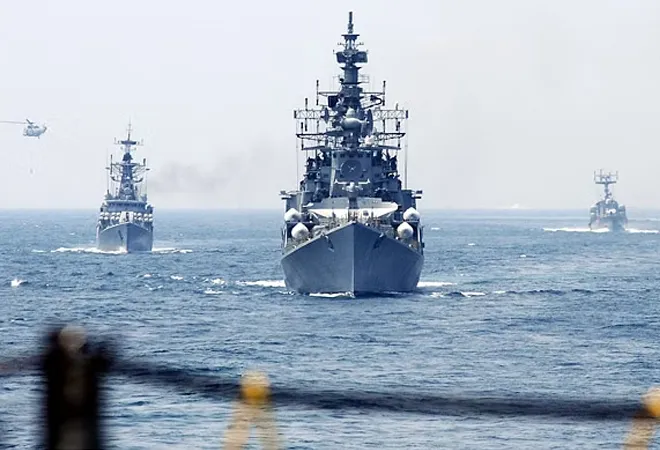-
CENTRES
Progammes & Centres
Location
Tensions between the Southeast Asian claimant countries and China have been on the rise in the South China Sea despite negotiations

The Indian Navy co-hosted the inaugural Association of Southeast Asian Nations (ASEAN)-India Maritime Exercise (AIME) with the Republic of Singapore Navy from 2–8 May 2023, with the aim to further strengthen the India-ASEAN defence cooperation. This exercise seeks to “promote maritime cooperation and enhance trust, friendship, and confidence amongst ASEAN and Indian Navies”. The exercise was conducted in two phases: The ‘Harbour Phase’ took place at the Changi Naval Base in Singapore from 2–4 May 2023. It witnessed “a range of professional and social interactions between the participating navies, which included cross deck visits; Subject Matter Expert Exchanges (SMEE) and planning meetings; Search and Rescue; Humanitarian Assistance; and Disaster Relief operations”. The ‘Sea Phase’ of the exercise was scheduled from 7–8 May 2023 in the South China Sea. The statement from the Singapore Navy read that the Sea Phase of the exercise took place “in the international waters along the transit route to the Philippines.” The Sea Phase of the exercise is expected to “provide an opportunity for the participating navies to develop closer links in the coordination and execution of operations in the maritime domain.” In this phase of the exercise, the ships performed various drills including helicopter cross-deck landings as well as maritime security, communication, and manoeuvring exercises. As part of the maritime security exercise, the participating ships tracked the movement of simulated vessels of interest, signalled through alerts from the liaison officers of the ASEAN member states stationed at Singapore’s Information Fusion Centre (IFC). There was also the practice of the Code for Unplanned Encounters at Sea (CUES), which is a confidence-building measure for the promotion of trust and reducing the possibility of any accidents and slip-ups at sea. Nine ships, six aircraft, and over 1,800 personnel from ASEAN member states and India were part of the exercise.
The Sea Phase of the exercise is expected to “provide an opportunity for the participating navies to develop closer links in the coordination and execution of operations in the maritime domain.”
The Chinese reaction
There were reports that when the exercise was being conducted in the Vietnamese Exclusive Economic Zone (EEZ), several Chinese maritime militia vessels were heading to Vietnam’s waters as they accompanied a Chinese research ship. These Chinese maritime militia vessels seemed to have changed course and were heading to where the AIME was taking place. According to Ray Powell, Project Lead at Gordian Knot Center project Myoushu (South China Sea), “A separate group of three Chinese vessels left the area of Zamora Reef (Subi Reef) on Monday morning and were monitored headed towards the area where the vessels were conducting joint exercises.” There have been ongoing clashes and tension between China and Vietnam, with China issuing a fishing ban and conducting activities inside Vietnam’s EEZ. There have been episodes of Chinese research vessels, accompanied by their coast guard vessels and nearly a dozen Chinese vessels including maritime militia and fishing vessels, entering gas block 04-03 of Vietsovpetro, a venture between Russia's Zarubezhneft and PetroVietnam. Similar incidents have also happened with Malaysia, the Philippines, and Indonesia. Despite the ongoing deliberations and negotiations on the Code of Conduct (COC) between the ASEAN and China, tensions have only been on the rise between the Southeast Asian claimant countries and China in the South China Sea.
The Southeast Asian countries were hesitant about involving external players in the dispute because some ASEAN countries had and still have strong economic links with China. There was also the concern that actions by outside parties might lead to further clashes and stall the negotiations of the COC. But with time, China’s growing assertiveness and expansionist tendencies, and the rising frequency of skirmishes in the disputed waters, a proactive role by external players is being appreciated and demanded as well. Therefore, this seems like an opportune time for India, too, to show that it can play a role in sending a message to the Chinese that its actions in the South China Sea are not acceptable and that abiding by international law is what is expected. Peace, stability, and security in the South China Sea would contribute to a free, open, and rules-based Indo-Pacific.
China’s growing assertiveness and expansionist tendencies, and the rising frequency of skirmishes in the disputed waters, a proactive role by external players is being appreciated and demanded as well.
ASEAN forms an important pillar in not only India’s Act East policy but also in India’s vision of a free, open, and inclusive Indo-Pacific. India has engaged in bilateral naval exercises with countries like Singapore, Indonesia, Thailand, among others, in Southeast Asia for a long time, but this is the first maritime exercise India has undertaken with the navies of the Philippines, Singapore, Brunei, Indonesia, Malaysia, Thailand, and Vietnam together. This is reflective of the fact that there is a growing realisation that just strong bilateral relationships with countries in Southeast Asia are not enough, but India needs to engage more proactively with the ASEAN as a body or group as well to mark its influence in Southeast Asia and the broader Indo-Pacific. Given that in the Indo-Pacific, there is no overarching regional architecture in place, the ASEAN and ASEAN-led organisations like the East Asia Summit (EAS) provide the much-needed platform for countries to discuss issues and concerns that impede the regional security, peace and tranquillity in the Indo-Pacific. In this context, the ASEAN and ensuring ASEAN centrality is the primary tenet in the Indo-Pacific policies of most countries like the United States (US), Japan, Australia, the European Union (EU), South Korea, and India.
The ASEAN centrality
ASEAN, for a long time, has been a noteworthy mediator and has successfully resolved disputes that have plagued the Southeast Asian region in the past; for example, the Cambodia-Vietnam conflict in the 1970s. Currently, there is a big question mark on this capability of the ASEAN, and on the waning of unity among the ASEAN member countries over certain issues, like the South China Sea dispute, which is no longer just a regional issue, but has a global impact and hinders regional security in the maritime domain. Given that the South China dispute is no longer just seen as affecting the security landscape of Southeast Asia, but also the Indo-Pacific region more broadly, most countries championing the notion of the free and open Indo-Pacific are upping their game and initiating measures to help claimant countries deal with an assertive China in the disputed waters. Therefore, this maritime exercise involving the navies of the ASEAN member countries in the South China Sea (the sea phase of the exercise) signals that India too is aiming to beef up its influence and present itself as a credible player in Southeast Asia and a dependable partner in dealing with Chinese encroachments in the South China Sea.
There is a big question mark on this capability of the ASEAN, and on the waning of unity among the ASEAN member countries over certain issues, like the South China Sea dispute, which is no longer just a regional issue, but has a global impact and hinders regional security in the maritime domain.
This exercise by India will help in the capacity-building of the navies of the ASEAN countries and further strengthen cooperation in the maritime domain between the two. The Indo-Pacific Ocean Initiative and the ASEAN Outlook on the Indo-Pacific, which underlines maritime cooperation as one of the primary areas of collaboration to work with like-minded countries in the Indo-Pacific, provides enough ground and opportunity for both India and ASEAN to work together to strengthen coordination and support for ASEAN countries, to help improve their maritime defence and security capabilities for dealing with a growing Chinese presence in their backyard.
But, what needs to be seen in the near future is, if the ASEAN countries would appreciate concerned parties and countries that have a stake in the South China Sea to raise this issue in platforms like the EAS so that global pressure can be put on China. This can, in turn, help facilitate the early signing of an effective and binding COC in the South China Sea that is acceptable to all parties and which follows international law.
Premesha Saha is a Fellow at the Strategic Studies Programme, Observer Research Foundation.
The views expressed above belong to the author(s). ORF research and analyses now available on Telegram! Click here to access our curated content — blogs, longforms and interviews.

Premesha Saha is a Fellow with ORF’s Strategic Studies Programme. Her research focuses on Southeast Asia, East Asia, Oceania and the emerging dynamics of the ...
Read More +